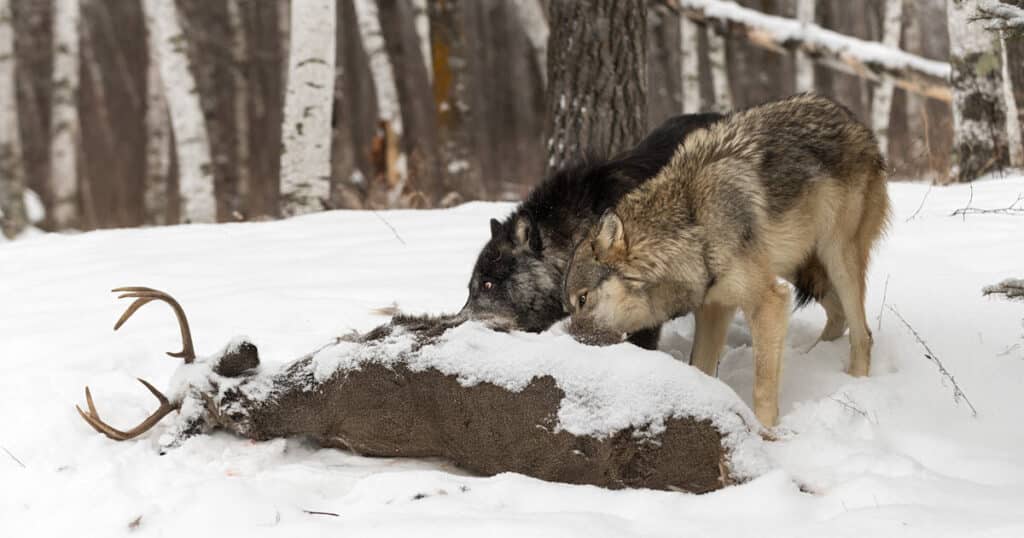Anyone who’s seen Bambi may already know that humans kill more deer than any wild animal does. However, we aren’t the only species that preys on deer. Around the world, deer have many natural predators, and in areas where deer have little interaction with humans, their main predators are other animals. To help you understand what eats deer and understand where deer stand in the food chain, read on!
In today’s article we will provide a comprehensive explanation of the natural predators of deer. We’ll also explore the important place deer occupy in the food web.
Let’s get started!
Natural Predators of Deer
Since deer species are found all over the world and in different types of climates, they have quite a wide range of natural predators.
However, there are some animals that tend to prey on deer more than others, which we’ve listed below.
- Wolves,
- Coyotes,
- Bears,
- Wild Cats,
- Killer Whales, and
- Alligators.
This is not an exhaustive list, and there are plenty of other animals that have been known to prey on deer, such as wolverines and eagles.
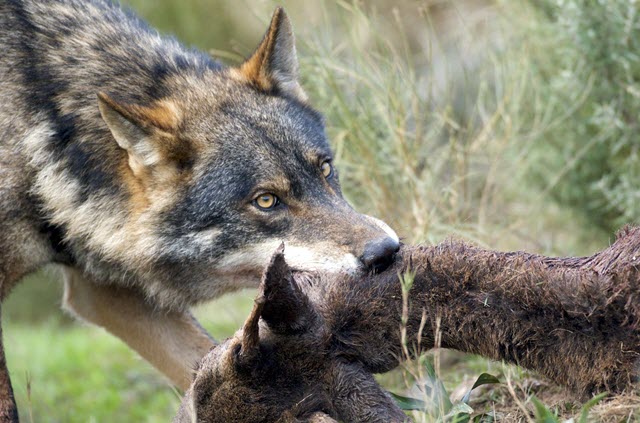
Vultures will also eat deer as carrion, but they will not hunt deer themselves. We’ll dive in and discuss each of the animals listed above in a moment, but first let’s examine how geography and the habitat a deer inhabits plays a role in their predation.
Deer Predators in North America
Since most of our readers are located in North America, you’re probably less interested in what animals prey on deer in other parts of the world, but it’s important to keep in mind that North America is a huge continent with a number of diverse ecosystems. As such, there are a variety of predators that hunt deer in the wild.
Europe expands on a horizontal basis, meaning most of the continent is in a fairly similar latitudinal range. This isn’t the case for North America.
The most northern regions of Canada and Alaska have a very different climate and topography than Mexico, and there is an abundance of diversity of ecosystems on the continent.
In North America, deer are found almost everywhere, but the same predators don’t appear in the same places. For example, in Alaska, killer whales have been known to prey on moose and other species of deer when they swim, whereas in Texas, coyotes and mountain lions are the deer’s primary natural predators.
Most of the deer predators found in North America are also found worldwide, so instead of listing all the North American predators separately, we’ve decided to include them with the list of worldwide predators.
List of Deer Predators Around the World
As we mentioned, some of the most common animals that prey on and eat deer include:
- Wolves,
- Coyotes,
- Bears,
- Wild Cats,
- Killer Whales, and
- Alligators.
And of course human hunters kill a number of deer around the world every year.
Let’s take a closer look at each of these natural predators of deer below.
Wolves
Aside from humans, wolves are the deer’s main predators. Wolves live all over the world and are fast, traveling in packs by night.
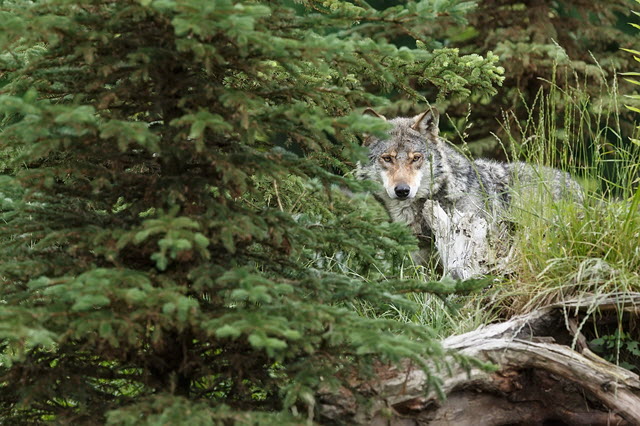
Though they are smaller than deer, deer don’t have much of a chance in a fight against a pack of wolves unless they are extremely fast.
Coyotes
Coyotes hunt deer in a way similar to wolves, except they are sneakier than wolves and tend to target smaller deer since a smaller deer is easier prey.
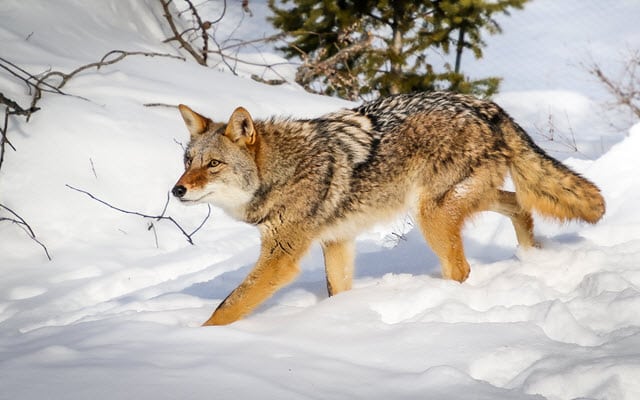
Since coyotes are smaller and slower than wolves, they have to sneak around more as opposed to relying on their speed.
Bears
Bears easily outsize deer, making them a fairly easy target. However, bears won’t necessarily seek out and hunt or attack the deer.
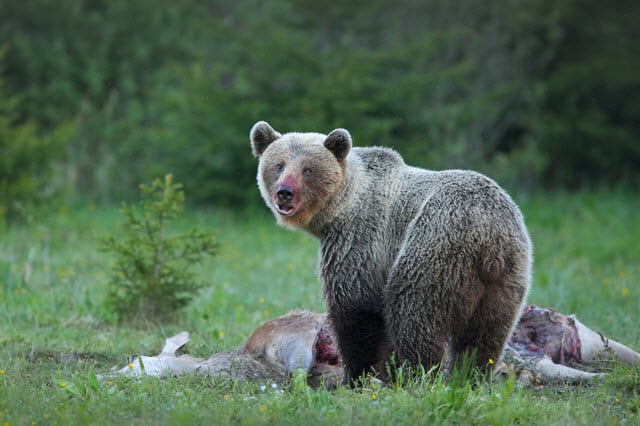
Though they do hunt and kill deer themselves sometimes, generally they would prefer instead to feed on the leftovers from animals such as wolves, dispersing the pack after they make a kill to steal their prey.
Wild Cats
Wild cats such as jaguars and mountain lions prey on deer on a regular basis, and some mountain lions will eat as many as one deer per week.
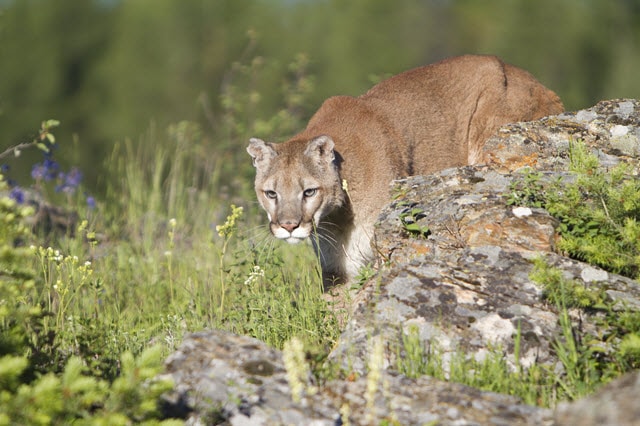
Unlike wolves and coyotes, wild cats rarely travel in packs and will hunt and consume the deer on their own, using stealth and speed to their advantage.
Killer Whales
This may seem a bit surprising, but in far northern areas such as Alaska and Canada, killer whales and on occasion even sharks have been known to prey on species of deer such as moose or reindeer while they are swimming.
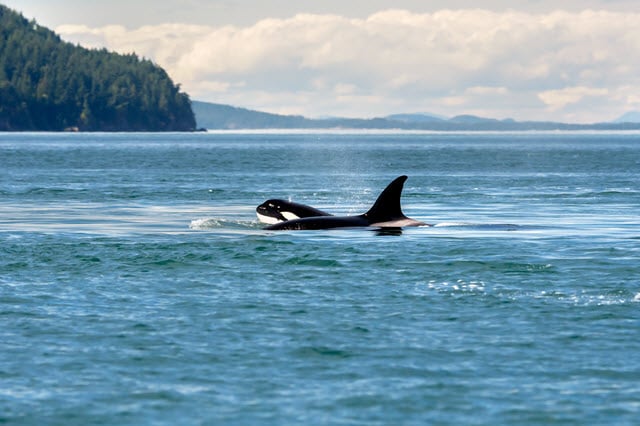
Some of these larger deer swim with regularity to escape bugs, or to reach islands or other coastal areas with their favorite foods.
Alligators
Alligators kill more deer than you would think, preying on deer when they come to the edge of a river to drink.
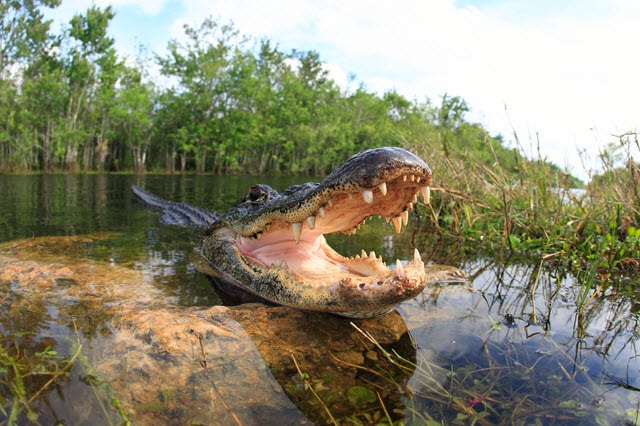
In swampy areas, they are the deer’s main predator, relying on their stealth to ambush their prey.
Which Animals Hunt Which Deer?
There are many different species of deer. Some of the smallest deer, such as the pudu of South America, are only about a foot tall. The moose, the largest species, is over five times that! Whereas a pudu might be easy prey, a moose is much more difficult to kill because of its size.
Generally speaking, larger species of deer will then have larger predators, but this also varies depending on location, and almost all over the world, wolves remain the main predators of almost all species of deer aside from humans.
Almost every culture prizes deer as a good source of food, and depending on where you are, the type of deer hunted by humans varies.
In northern Russia and Scandinavia, reindeer are bred and hunted as food, whereas in America, elk is a favored game meat.
The Deer’s Place in the Food Web
All animals play an important role in the ecosystem, and since deer are found all around the world, their importance is vital for the environment on a global and local scale.
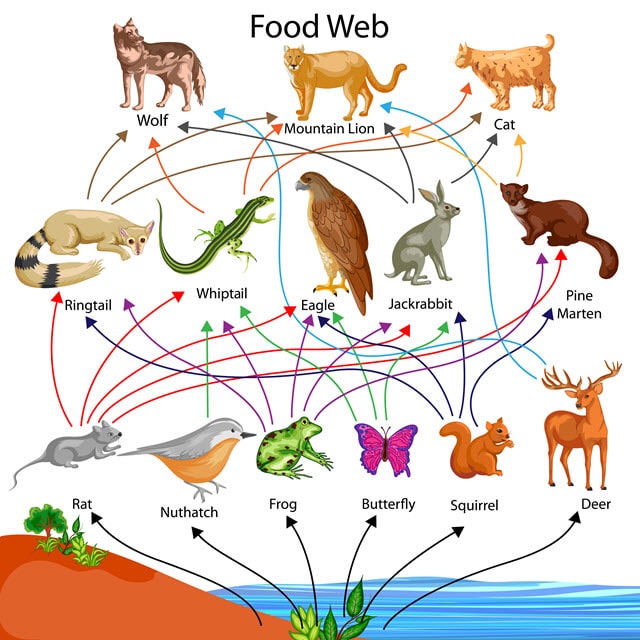
Deer are herbivores, meaning they eat only plants. A deer’s diet changes depending on location and time of year, but most will eat grass, leaves, and other greens.
Deer droppings then return the nutrients from the plants into the ground, and when deer shed their antlers in winter, these will also decompose and serve as food not only for the earth, but other animals.
Deer antlers are extremely high in nutrients and are such an excellent energy source that even deer will sometimes consume their own antlers.
However, deer antlers and droppings are not the only way the animal supports the ecosystem. Deer have many predators, and for some animals such as wolves they can be an extremely important food source.
This may seem violent and sad since deer only feed on plants, but it’s a natural part of the circle of life.
In fact, many cultures treasure deer as one of the most important sources of life since the entire animal can be used not only for food and decoration, but for leather and fur.
How Deer Avoid (Escape from) Predators
There are several ways that deer escape or avoid predators, the most common being fleeing. Deer have incredible agility, and as soon as they spot a predator, they will take off.
You’ve probably witnessed this yourself if you’ve taken a walk through the woods and been in the presence of deer. While some deer are accustomed to humans, most will flee at the first sight of a person.
Escaping predators is not an easy task, and wolves can easily outrun a deer, so there are a few tricks deer have to avoid predators before they need to flee.
Camouflage
Deer are often hard to find. Walking through the woods, you often won’t even notice them until they run.
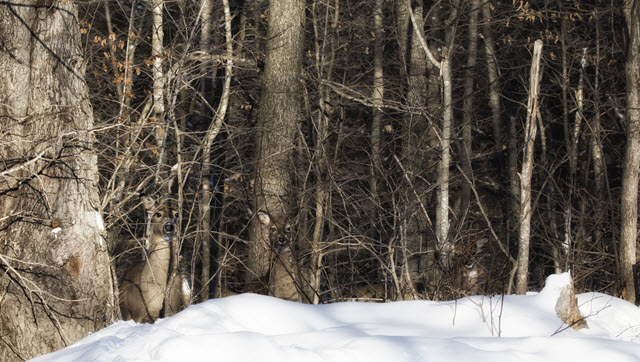
Out in the open, deer are easier to spot, which is why they will often hide in the woods where their coat blends in with the trees, which provide natural cover.
Deer are also very good at being still, which is useful when avoiding predators that can only see movement.
Heightened Hearing
Deer do not have a significantly wider hearing range than humans, though it is somewhat wider. They can pick up lower frequencies, but deer whiles with high frequencies will probably be ineffective.
Unlike humans, deer are much better at isolating and amplifying sounds from a distance.
Hunters know that even the slightest movement can send a deer sprinting, which proves that deer are good at recognizing sounds that don’t typically belong in the woods or can be potentially threatening.
Planning
Deer tend to have a certain area where they live, and if they can, they like to sleep in the same spots. While they are not as capable of in-depth planning as humans, they are able to discern areas that offer more protection than others.
Deer tend to sleep in areas that offer a lot of cover and protection from predators, whether it be through camouflage or easy access to escape routes.
A deer knows its territory better than you probably know your house, so if it takes off, you probably won’t have much luck finding it.
What Kills Deer the Most
Humans kill deer more than any other animal. It’s hard to estimate how many deer humans kill annually since deer are hunted worldwide and include a variety of species such as moose, elk, and reindeer.
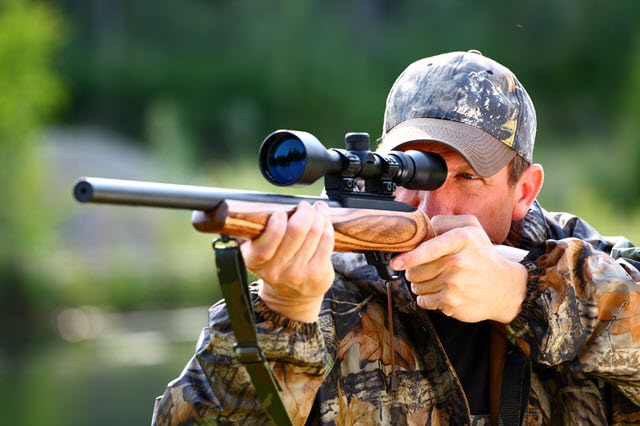
However, it is estimated that in some areas human hunting accounts for over half of deer mortality, and that isn’t including deer that are accidentally killed by vehicles.
Roadkill incidents account for nearly 10% of deer deaths in some areas, so beware of deer crossing signs. Deer that die due to roadkill can’t be used for meat and don’t necessarily decompose as naturally as deer that die naturally.
What Animal Kills the Most Deer?
Though humans are technically animals, let’s set them aside for a moment and consider which animal probably kills the most deer.
This information could be useful if you’re hoping to hunt deer as it allows you to keep in mind the other predators which deer might be avoiding.
In addition, understanding the food chain is important for environmental preservation. For example, if deer were to suddenly disappear, this would disrupt the diets of many animals and have major consequences for conservation.
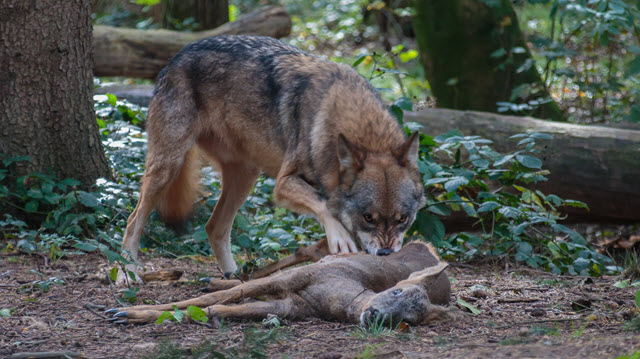
It’s impossible to say what animal kills the most deer worldwide since deer live all over the world. In some areas, mountain lions kill more deer than any other animal. But in other areas this is not the case.
Worldwide, wolves probably kill more deer than any other animal. This is probably because wolves are much more widespread than big cats (which may be better at hunting deer). Wolves are true apex predators in many habitats in which deer live.
Wolves are well-adapted to survive in a variety of environments, so they can be found almost all over the world. This makes them the most likely animal to kill a deer, but wolves do not feed exclusively on deer.
Wolves will eat almost anything they can kill, so if there is a small population of deer in an area, wolves might prefer to take on easier prey.
How Wolves Hunt Deer
We talked about this a bit earlier when describing the different predators of deer, but since wolves are a deer’s primary predator, it’s worth taking some time to look at them in greater detail.
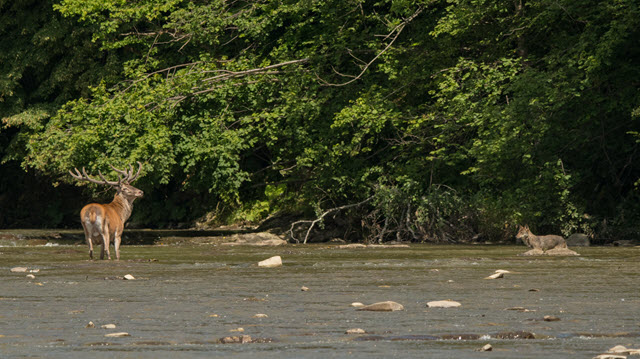
If you’re a hunter, wolves are probably your main competition. It’s a good idea to think about how they might be going after your target.
First of all, wolves hunt in packs. There is no such thing as the romantic idea of a lone wolf. This means their hunting effort is collective.
They will work as a team to target a deer. Wolves will often surround a single deer or a herd while they are sleeping or feeding.
Wolves also tend to hunt deer seasonally, though they need to eat all year-round and will also attack during other times.
Since deer are weakest during the winter, this is the ideal time for a wolf to attack. Indeed, the majority of deer killings due to wolves occur during this season.
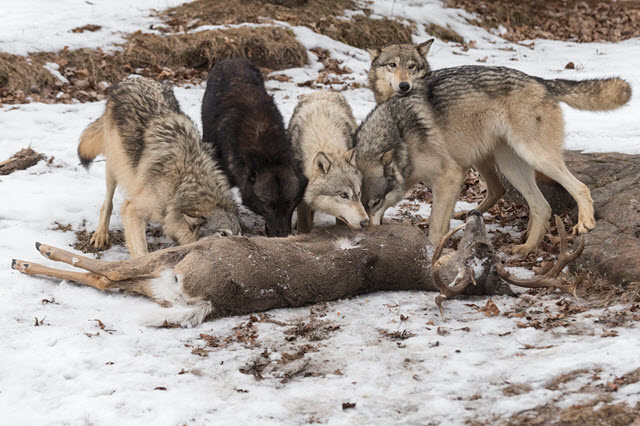
Wolves will attack deer they perceive to be as weaker and thus easier prey, so smaller and younger deer tend to be preferred targets.
Bucks and larger deer would be more difficult for a wolf to kill, but wolves will attack them if necessary.
Wolf Hunting
In some areas, wolves have almost entirely disappeared because of human development. Wolves also sometimes wander out of their natural territory, which can be dangerous not only for deer, but for farm animals.
If wolves invade a particular area, this can disrupt the natural food chain. The result is a decrease in the deer population. When this happens, hunters will sometimes begin targeting wolves as well.
Final Thoughts About the Predators that Eat Deer
There is no single answer to the question, “What eats deer?” Many different kinds of animals prey on deer, so the answer depends on the location and type of deer.
However, the primary killer of deer worldwide is humans, followed by wild dogs such as wolves and coyotes.

